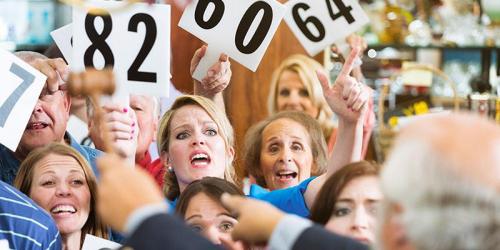
Australians love an auction. Every Saturday, thousands of us trawl the neighbourhood, register for a paddle, and vie for a slice of the great Australian dream. Real estate aside, our love extends to online, art and charity auctions. Governments love auctions too – both as buyers and sellers. Government tenders are a type of auction, where prospective suppliers bid (on price and quality) to offer their services.
And governments have also embraced new and innovative auction types, including combinatorial auctions to sell access to telecommunications air space; and reverse auctions to buy renewable energy.
So why do we love auctions so much? When are they useful? And what drives auction behaviour? Auctions have actually existed for over 2500 years and the main advantages of selling by auction are summed up nicely in this quote: “For manuscripts and antiques, too, prices must be remade for each transaction... how can one discover the worth of an original copy of Lincoln's Gettysburg Address except by auction method?”
For the homeowner selling their unique property; for the buyer looking to procure a particular service with particular level of quality; or for the government looking to sell literal airspace, an auction avoids the problem of having to come up with the “right” selling price – instead giving interested parties the right to bid for victory.
Of course, where there are human participants, there are human biases. And auctions are no exception. One important driver of behaviour in auctions is anchoring - that is, where bidders are influenced by the starting price or first bid. Anchoring can play out a little differently in auctions than in other market exchange situations – we’ll cover this in more detail in the next blog, so stay tuned!
A particularly important driver of behaviour in auctions is the endowment effect – that is, we tend to value something more when we think of it as our own, a feeling that is compounded when this thing is scarce or unique. In an auction, this means you’re often more willing to pay more if you expect to win. Once you’ve started to bid, your expectation of winning goes up and the thought of losing becomes unimaginable, driving you to bid higher and higher in an attempt to win what is “rightfully yours”.
The problem is that all bidders tend to suffer the same feeling, which can lead to bidding wars that spiral out of control. A great example of this is the story of how in 1973 the American Broadcasting Company broke the record for highest amount paid to broadcast a single film.
Once the auction started, bidding quickly escalated, with CBS executive Robert Wood recalling “Like a guy who had lost his mind, I kept bidding…when [American Broadcasting Company] finally topped me, my main feeling was relief.”
After the auction, maybe feeling the sting of buyer’s remorse, American Broadcasting Company executive Barry Diller vowed the network would never again enter an auction situation. Which might be fine for a television executive in the 1970’s, but it’s probably unrealistic for any of us to make a similar vow.
So if you want to avoid these pitfalls, what can you do? First, before you start bidding, set a ceiling price and commit to it. Writing the commitment down is a good way to strengthen your resolve.
Second, try to minimise the chance you’ll break your commitment. For a time-limited auction (where bidders have a chance to raise their bid as the auction progresses), try to bid towards the end of the auction. This is because the longer you’re the high bidder, the stronger your feeling of ownership, and the greater the risk you’ll break your commitment.
For an online auction, once you’ve submitted your bid, try not to log in again until the auction is over. And for a house auction, tell a friend your ceiling price and bring them along to stop you from crossing the line.
Remember auctions are usually designed to maximise the price for the seller. So while you might not be able to overcome your behavioural biases completely, a little forward planning can help stop your resolve from going…going…gone!
Further reading
Krishna, V. (2009). Auction theory. Academic press.
McAfee, R. P., & McMillan, J. (1987). Auctions and bidding. Journal of economic literature, 25(2), 699-738.
Thaler, R. (1980). Toward a positive theory of consumer choice. Journal of Economic Behavior & Organization, 1(1), 39-60.
Carmon, Z., & Ariely, D. (2000). Focusing on the forgone: How value can appear so different to buyers and sellers. Journal of consumer research, 27(3), 360-370.
Heyman, J. E., Orhun, Y., & Ariely, D. (2004). Auction fever: The effect of opponents and quasi-endowment on product valuations. Journal of Interactive Marketing, 18(4), 7-21.
MacKenzie, B. (1974). "When Sober Executives Went on a Bidding Binge." TV Guide, June 22, 1974.
Matthews, G. (2011). Study Backs up Strategies for Achieving Goals. Dominican University, http://www.dominican.edu/dominicannews/study-backs-up-strategies-for-achievinggoals, 8-27.

